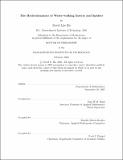The hydrodynamics of water-walking insects and spiders
Author(s)
Hu, David L., 1979-
DownloadFull printable version (72.04Mb)
Other Contributors
Massachusetts Institute of Technology. Dept. of Mathematics.
Advisor
John W.M. Bush.
Terms of use
Metadata
Show full item recordAbstract
We present a combined experimental and theoretical investigation of the numerous hydrodynamic propulsion mechanisms employed by water-walking arthropods (insects and spiders). In our experimental study, high speed cinematography and flow visualization techniques are used to determine the form of the flows generated by water-walkers. In our supporting theoretical study we provide a formal fluid mechanical description of their locomotion. We focus on the most common means of walking on water such as the alternating tripod gait, rowing, galloping and leaping. We also examine quasi-static modes of propulsion in which the insect's legs are kept stationary: specifically, Marangoni propulsion and meniscus-climbing. Special attention is given to rationalizing the propulsion mechanisms of water-walking insects through consideration of the transfer of forces, momentum and energy between the creature and its environment.
Description
Thesis (Ph. D.)--Massachusetts Institute of Technology, Dept. of Mathematics, 2006. This electronic version was submitted by the student author. The certified thesis is available in the Institute Archives and Special Collections. Includes bibliographical references (leaves 142-152).
Date issued
2006Department
Massachusetts Institute of Technology. Department of MathematicsPublisher
Massachusetts Institute of Technology
Keywords
Mathematics.